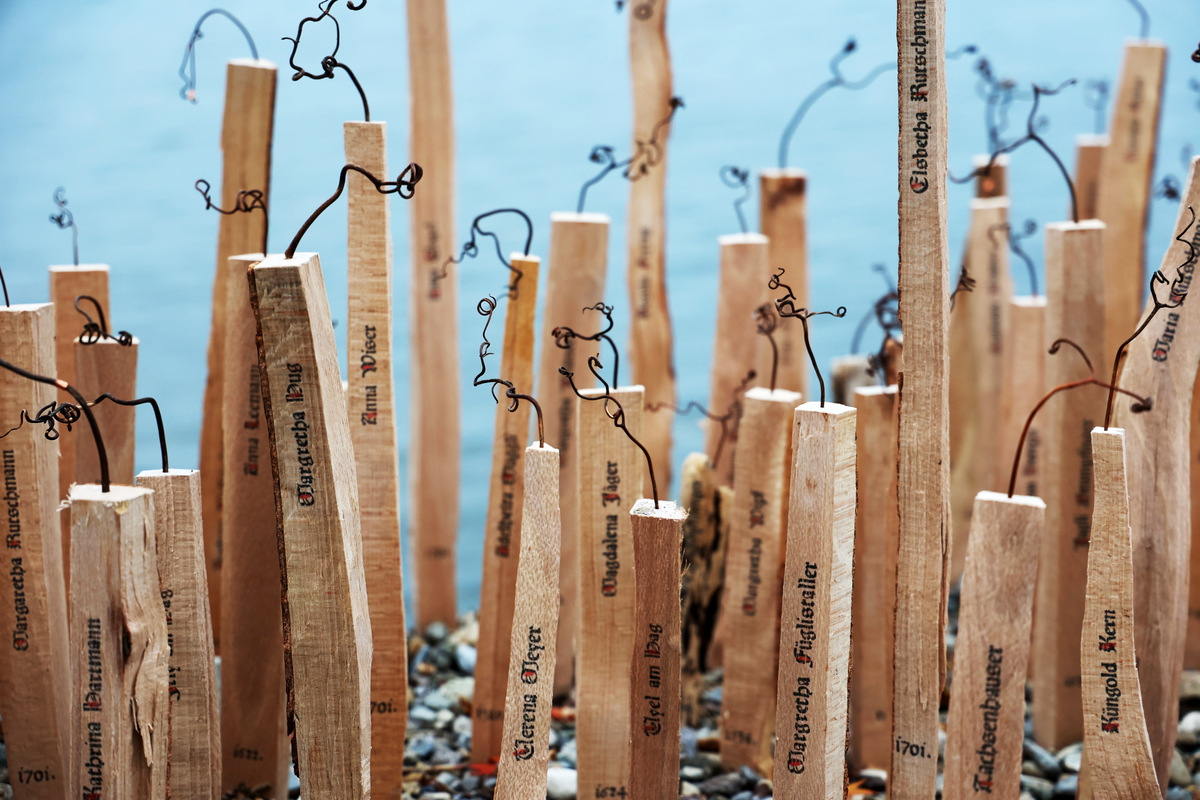Eighty-four wooden statues commemorate the victims of the witch trials in canton Zürich. From 1487 to 1701, these 79 women and 5 men were found guilty of a variety of unprovable acts and sentenced to the death penalty.
This memorial both honors the lives of the deceased and interrogates anew our modern belief system: How did the people of Switzerland alter their belief that it was proper to murder citizens after extracting confessions under torture and instead decide to abolish the death penalty for any crime? Or move from accusing women of impossible acts of weather magic and fornication with an imaginary creature to extending to them the right to vote?
More urgently: What beliefs do we currently hold that are as ill informed as those that led the councillors to condemn these people? What actions do we champion today, and call just, over which our progeny will despair?
MATERIALS
The firewood used for the project came from the forests of Erlenbach and Küsnacht. Driftwood from Lake Zürich was used for
the four women who were drowned instead of burned.
The grapevine tendrils grew in the vineyards of Turmgut Erlenbach and Landolt Weinegg. Just as these trees and grapevines grew in Zürich, so did these belief systems.
The height of each memorial represents the number of malicious deeds supposedly perpetrated by each person. These accusations include making neighbors ill, causing hailstorms by throwing rocks into water, harming livestock, and stealing milk from an axe handle stuck into a post. In order to merit an execution by fire, a person’s confession must include a denial of god and allegiance and physical contact with a devil. The terms used in the transcripts of the trials to describe conjugal relations are euphemistic but unmistakable.
 Rutschmann Family from Wasterkingen |  Katharina Franck, drowned in the Limmat River |
 Elsa Mock and her daughters Anna and Barbara Knupp |
 |
The alphabet was drawn from the type in Malleus maleficarum (The Hammer of Witches) printed circa 1486/1487 by Peter Drach der Mittlere.
This page contains the name Anna. Twenty victims had this name. I created the capital K and W glyphs as they do not exist in the Latin text.
ACKNOWLEDGEMENTS
I first learned about the witch trials on a walking tour of Zürich led by historians at the Frauenstadtrundgang Zürich.
Listen to a radio broadcast about the tour in German.
In the well-researched books by Otto Sigg, I encountered the meticulous records of the individual trials.
I want to express my gratitude to Mr. Sigg, whose diligent scholarship in the State Archives of the Canton of Zurich collecting and translating the handwritten texts from Early New High German into modern German made this project possible.
Research by Otto Sigg
Hexenmorde Zürichs und auf Zürcher Gebiet. Nachträge und Ergänzungen zur Dokumentation 2012
Hexenprozesse mit Todesurteil
Justizmorde der Zunftstadt Zürich, Dokumentation zu den 79 mit Todesurteil endenden sogenannten Hexenprozessen im Hoheitsgebiet der Stadt Zürich 1487 – 1701
David Meili’s dissertation Hexen in Wasterkingen. Magie und Lebensform in einem Dorf des frühen 18. Jahrhunderts on the Wasterkingen trials also expanded my understanding of the historical context and belief systems that fostered the persecutions in 1701.
Special thanks to Luka at Martin Stiftung in Erlenbach for cutting each piece of firewood to just the right length.
EXCERPT
Almost all of the trials in Hexenprozesse mit Todesurteil by Otto Sigg include a version of this language in the judgement:
| Because of the wicked, ungodly, unchristian and shameful life of Elisabeth Gugerlin, which has now been told, as she not only corrupted and killed people with the help of the evil one, including her relatives, but also surrendered to the evil one, it is decided that she should be ordered to the executioner. He shall bind her hands and lead her out to the Sihl on the gravel, put her there on a rack, hitch her to a stud, and so burn her on the rack at the stud, so that her flesh and bones become ashes, then command the ashes to the running water. And she shall hereby be punished by the court and the law. And if anyone, whosoever he be, shall punish or avenge her death by word or deed, secretly or publicly, or shall cause the same to be done, he and they shall stand in the guilt and bonds in which the aforementioned Elsbetha Gugerlin now stands. Whatever property she has is forfeited to the community by her grace. | Um welch jetzt erzählten, ihr, Elisabeth Gugerlins verruchten, gottlosen, unchristlichen und schändlichen Lebens wegen, als sie nicht allein mit Hilfe des Bösen Leute, als gleich darunter auch ihre Verwandten, verderbt und umgebracht, sondern sich auch an den Bösen ergeben hat, ist zu ihr also gerichtet, dass sie dem Nachrichter befohlen werden soll. Der soll ihr ihre Hände binden und sie hinaus zu der Sihl auf das Grien [Kies] führen, [sie] daselbst auf eine
Hurde setzen, an eine Stud heften und also auf der Hurd an der Stud verbrennen, inmassen ihr Fleisch und Bein zu Asche werden, dannenthin die Asche dem fliessenden Wasser befehlen.
Und soll sie hiermit dem Gericht und Rechten gebüsst haben. Und ob jemand, wer der wäre, der solchen ihren Tod ahndete oder äferte mit Worten oder Werken, heimlich oder öffentlich, oder das schüfe getan zu werden, dass der und dieselben in den Schulden und Banden stehen sollen, darin die genannte Elsbetha Gugerlin jetzt gegenwärtig steht. Was Guts [an Vermögen] sie hat, ist gemeiner Stadt auf ihre Gnade verfallen. |



